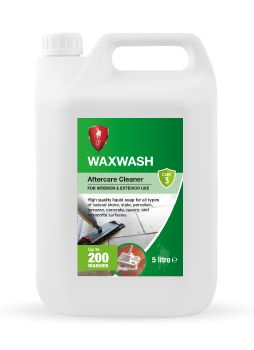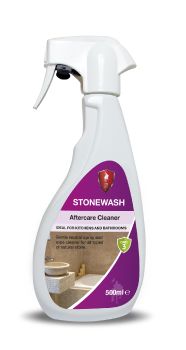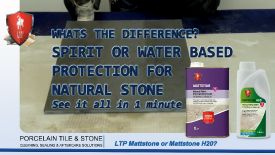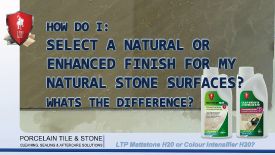
Heritage Limestone – image kindly supplied by indigenous.co.uk
Newly installed internal stone tiles need to be sealed to protect them from stains. Whilst really hardwearing, stone is generally slightly porous and sensitive to acid and this makes it vulnerable to staining. Good surface protection helps in other ways too – it retains the tile’s aesthetic; it makes ongoing maintenance easier (because you’re not constantly battling a build-up of dirt and residue) and, in textured floor tiles, it helps to retain slip resistance.
This advice relates to all types of stone tile, regardless of material and finish. The most popular types include limestone, travertine, granite, marble and slate. In our latest blog, we run through the best products and methods to use, to protect your stone floor and wall tiles.
Surface sealers v impregnating sealers
Protective sealers generally fall into two camps – surface sealers and impregnating sealers:
Surface sealers create a surface film that protects the stone. The downside is that this tends to disguise the tile’s natural appearance and it stops the surface from breathing. Any damp or moisture within or underneath the stone will be unable to escape and will become trapped underneath the sealer. This will create a milky appearance.
In contrast, impregnating sealers are absorbed into the stone’s porosity, so they don’t create that surface film. The stone retains its natural appearance and is able to breathe. Colour enhancing impregnating sealers work in the same way but they enrich colour tone.
Both types of sealer are either solvent/spirit-based or water-based. Historically, the molecules of a solvent/spirit-based sealer were smaller than water, so they tended to penetrate more quickly and deeply, which provided a better seal. This is no longer the case. Today’s high-quality water-based sealers are equal to or superior to their solvent/spirit-based equivalents. They also bring with them safety and environmental benefits, as they are low VOC.
Applying a sealer
Before applying your sealer, give your tiles a thorough clean to remove any residue. This will prevent it from becoming trapped underneath the sealer and compromising the performance of the protector, as well as the tile’s aesthetic. We recommend LTP Grimex, diluted 1:10 in warm water. Apply with a cloth or mop and wipe off thoroughly with a clean, damp cloth.
For indoor stone floor and wall tiles, we recommend either LTP Mattstone H2O for a completely natural finish or LTP Colour Intensifier & Stoneblock H2O which increases natural colour vibrancy. Both are applied generously onto clean, dry tiles. A foam roller or paint brush is recommended for rough cut, tumbled, textured or riven surfaces and a sealant applicator, lint-free cloth, lamb’s wool applicator or sponge for honed, smooth and polished stone.
On very porous stone, further coats should be applied at hourly intervals until the surface is saturated; these tend to be the textured tiles, rather than the smooth or ‘honed’ surfaces. Any excess should then be removed from all tiles after one hour with an absorbent towel or microfibre cloth; in very large areas, a buffing machine may be used.
In the case of highly porous encaustic tiles, we recommend sealing tiles before and after grouting. This protects the stone from grout residue. Terracotta also needs sealing but the procedure here is slightly different, as explained in our blog, How to protect terracotta tiles.
TOP TIP! On wall tiles, always apply the sealer from the bottom up. This will prevent the solution from running down the surface of the tiles and drying unevenly, before you’ve had chance to work it into the stone.
Here are links to step-by-step instructions for each treatment:
LTP Colour Intensifier & Stoneblock H2O
Topping up protection
Natural stone tiles may begin to show signs of wear and patches of ingrained dirt after around 3-5 years, depending on location and traffic. To top up protection, the tiles should be thoroughly cleaned with LTP Grimex and the sealer re-applied.
Ongoing maintenance
Stone tiles should always be cleaned with a gentle pH-neutral detergent. We recommend our LTP Waxwash for floors and LTP Stonewash for wall tiles. Both will thoroughly clean whilst protecting the newly applied sealer. A regular routine cleaning regime will make ongoing maintenance easier and will retain the stone’s aesthetic – and, in case of textured floor tiles, its slip resistance. Most stone surfaces will benefit from a wet clean around once a week.


For more advice, please visit https://www.ltp-online.co.uk, call the LTP technical team on 01823 666213 or email [email protected]





